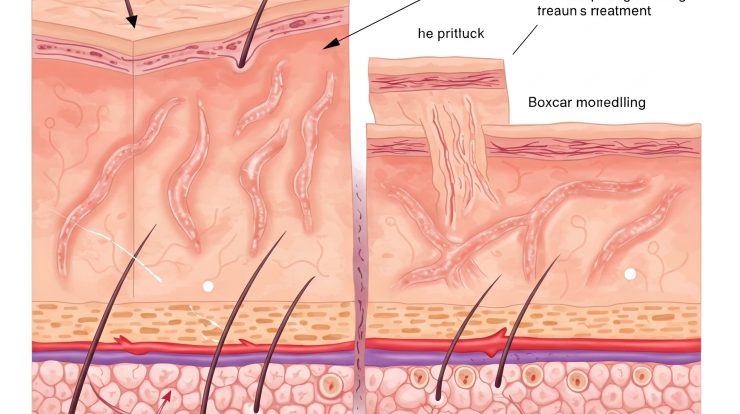
Deep, indented acne scars (atrophic scars) can be a lasting and frustrating reminder of past breakouts. Caused by damage and loss of underlying collagen during the inflammatory healing process, these scars don’t typically fade on their own. Fortunately, advancements in dermatology offer effective treatments, and microneedling, also known as Collagen Induction Therapy (CIT), has become a popular and well-regarded option for improving their appearance. But what kind of results can you realistically expect, especially when dealing with deep acne scars? This article explores how microneedling works and the outcomes you might anticipate.
How Microneedling Addresses Deep Acne Scars
Microneedling utilizes a specialized device equipped with numerous tiny, sterile needles. When passed over the skin, these needles create controlled, microscopic punctures (micro-injuries) in the dermis. This process triggers the body’s natural wound-healing cascade:
- Inflammatory Response: The micro-injuries initiate a healing response.
- Collagen & Elastin Production: Growth factors are released, stimulating fibroblasts (cells responsible for producing connective tissue) to generate significant amounts of new, healthy collagen and elastin.
- Tissue Remodeling: Over weeks and months, this new collagen helps to remodel the scarred tissue, gradually filling in the depressions from below and improving the overall texture and firmness of the skin.
Essentially, microneedling encourages your skin to repair itself from the inside out, thereby reducing the depth and visibility of indented scars.
What Kind of Results Can Be Expected for Deep Scars? (Managing Expectations)
While microneedling can offer significant improvement, it’s crucial to have realistic expectations, especially for deeper scars:
- Improvement, Not Erasure: The primary goal and realistic outcome is improvement in the depth, texture, and overall appearance of the scars, making them shallower and less noticeable. Complete removal of deep, established scars is very rare with any treatment, including microneedling alone.
- Best for Certain Scar Types: Microneedling generally yields the best results for rolling scars (broad depressions with sloping edges) and shallow-to-medium depth boxcar scars (wider scars with defined edges). While it can offer some improvement for ice pick scars (deep, narrow pits), these often require more targeted treatments like TCA CROSS for optimal results, sometimes in combination with microneedling.
- Multiple Sessions Are Essential: This is non-negotiable for seeing meaningful results, especially with deeper scars. A single session will likely yield minimal change. A series of 3 to 6 sessions (or sometimes more for very deep scarring), typically spaced 4 to 6 weeks apart, is usually required to allow for adequate collagen remodeling between treatments.
- Gradual Results: Collagen production and skin remodeling take time. You won’t see the final results immediately after a session. Improvements appear gradually over several weeks and months following each treatment, with cumulative benefits seen after completing the series. Full results are often assessed 3-6 months after the last session.
- Individual Variability: Results depend heavily on factors like the depth and age of the scars, your skin type and tone, your individual healing response, the specific microneedling device used (pen vs. roller, needle depth), the practitioner’s technique, and adherence to post-treatment care.
- Often Best with Combination Therapy: For deep or complex scarring, dermatologists frequently recommend combining microneedling with other procedures for enhanced results. This might include:
- Subcision: To release fibrous bands tethering down rolling or boxcar scars before microneedling.
- PRP (Platelet-Rich Plasma): Applying PRP derived from your own blood during or after microneedling may boost healing and collagen production.
- Alternating Treatments: Combining microneedling sessions with laser treatments or chemical peels over a longer treatment course.
The Microneedling Procedure (Brief Overview)
- Consultation: Assessment of scars and skin type, discussion of goals and expectations.
- Preparation: The skin is cleansed, and a topical numbing cream is usually applied for 30-60 minutes to minimize discomfort.
- Procedure: The numbing cream is removed, the skin is cleansed again, and a sterile needle cartridge attached to a microneedling device (usually a pen) is passed over the treatment area, creating micro-punctures. A serum (like hyaluronic acid or PRP) may be applied during the process.
- Post-Procedure: The skin will typically appear red and feel sensitive, similar to a moderate sunburn. Pinpoint bleeding may occur but usually stops quickly. Soothing serums or masks may be applied.
- Recovery/Downtime: Redness and mild swelling usually subside within 1-3 days. Skin might feel dry or slightly rough for a few days. Strict sun avoidance and gentle skincare are crucial during healing.
Enhancements: Microneedling with Radiofrequency (RF Microneedling)
A more advanced option, RF microneedling devices deliver radiofrequency energy through the needles deep into the dermis. This added heat further stimulates collagen and elastin production and promotes tissue tightening. RF microneedling may offer enhanced results compared to traditional microneedling for certain types of deeper scars and skin laxity, but often involves slightly more downtime and higher cost.
Factors Influencing Microneedling Results
- Type, depth, and age of scars
- Number of treatment sessions performed
- Skill and experience of the practitioner
- Device and needle depth used
- Individual skin type and healing response
- Consistent use of recommended post-procedure care (especially sun protection)
Conclusion
Microneedling (Collagen Induction Therapy) is a proven and effective minimally invasive treatment for improving the appearance of various atrophic (indented) acne scars, including deeper types like rolling and boxcar scars. By stimulating the skin’s natural collagen production, it can lead to a noticeable reduction in scar depth and an improvement in overall skin texture.
However, achieving significant results, particularly for deep scars, requires realistic expectations, a commitment to multiple treatment sessions (typically 3-6+), and patience, as improvements manifest gradually over several months. Microneedling often yields the best outcomes when performed by an experienced practitioner and potentially as part of a combination therapy approach tailored to your specific scarring. It represents a valuable tool in the dermatological arsenal for scar revision, offering meaningful improvement rather than complete erasure.
